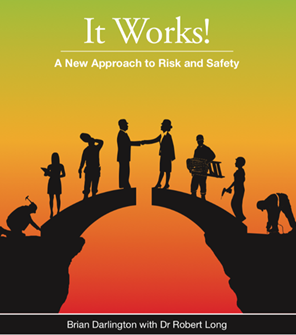The Safety of Space and Place
 We have known for some time how space and place amplifies harm (Nash, 2006, Inescapable Ecologies, A History of Environment, Disease and Knowledge). When we pay attention to the non-measurables in life and being we begin to envision safety in a completely different way to naming and controlling hazards. Indeed, the burden of a material/physical focus foisted on Safety by an engineering worldview feeds an obsession with looking for risk in the wrong place. When we learn to dump the language of brain-centrism and body-as-machine metaphors we learn a new language that envisions risk differently (https://www.humandymensions.com/product/envisioning-risk-seeing-vision-and-meaning-in-risk/ ).
We have known for some time how space and place amplifies harm (Nash, 2006, Inescapable Ecologies, A History of Environment, Disease and Knowledge). When we pay attention to the non-measurables in life and being we begin to envision safety in a completely different way to naming and controlling hazards. Indeed, the burden of a material/physical focus foisted on Safety by an engineering worldview feeds an obsession with looking for risk in the wrong place. When we learn to dump the language of brain-centrism and body-as-machine metaphors we learn a new language that envisions risk differently (https://www.humandymensions.com/product/envisioning-risk-seeing-vision-and-meaning-in-risk/ ).
Nash’s work shows how through History that humans have harmed themselves through the way they organize in space and place without question. Researchers like Nash and Bachelard (The Poetics of Space ) demonstrate how important the imagination is in understanding harm. We know that what we believe about space and place (https://safetyrisk.net/can-what-you-believe-make-you-well-or-sick/ ) and even the metaphors and language we use for illness (Sontag, 1977, Illness as a Metaphor – https://safetyrisk.net/can-what-you-believe-make-you-well-or-sick/; Radley, 1994, Making Sense of Illness, The Social Psychology of Health and Disease) shape the way we self-harm. One of the most common ways we harm ourselves is though Technique, the quest for total efficiency (Ellul, 1964, The Technological Society – https://monoskop.org/images/5/55/Ellul_Jacques_The_Technological_Society.pdf ).
When you cannot envision risk, counting injuries looks like you care about and have a passion for safety.
Envisioning is about big picture thinking. Envisioning risk is about understanding risk outside of the bounds of mono-disciplinary safety.
When we learn to jump outside of the bounds of engineering, we begin to envision risk. This is why the language of ‘ecologies’ is so important in understanding persons, culture and harm (https://safetyrisk.net/so-you-want-culture-change-2/ ). Once one learns to step outside of the confines of numerics, metrics and the nonsense of zero, a new vision of living and moving in risk emerges. When we dump the nonsense of prediction, controls, mechanics and omnipotence, we learn to embrace persons in a holistic way that humanizes risk.
A good example is in the nonsense development of ‘hot desking’ (https://safetyrisk.net/selective-safety-and-well-being/ ). Hot desking is the quest for efficiency on full show. Humans be damned, let’s economise, you know it saves money. Hot desking is Technique on full display. However, most harm in space and place is much more subtle and insidious.
Safety is a disposition of Mind in place and space, not a mechanical strategy for controlling hazards.
When your methodology (worldview) is shaped by zero, primed by zero and framed by zero, no wonder the trajectory is the harm of persons.
It’s a shame that the study of Ergonomics in safety is so narrow and that human bodies are not understood holistically (https://cllr.com.au/product/holistic-ergonomics-unit-6/ ). Traditional ergonomics simply reinforces the behaviourist assumptions of safety that understand ‘human factors’ as humans as ‘factors’ in a system, not as persons in an ecology. How strange that human factor safety is NOT about persons but about bodies as machines in a system. The machine metaphor is a disaster for persons just as the brain-as-computer metaphor is a disaster for the human Mind. The body is NOT a machine (https://aeon.co/essays/how-ecological-thinking-fills-the-gaps-in-biomedicine ).
So, what can we do to prevent harm?
- The beginning of understanding harm in safety is to dump the nonsense of behaviourism, engineering and scientism as a frame for understanding persons. As long as the ideology and language of zero dominates the safety space, persons will be more greatly harmed than ever.
- The next thing is to realise that Safety embodies a philosophy (methodology) that it never studies or discusses. And it is out of this insidious philosophy that much dehumanisation of persons emerges. Safety will never improve by putting heads in the sand and imagining that safety is some kind of objective authoritarian process.
- Moving away from a regulatory focus in curriculum is also critical if we are to create a safe space for persons to work.
- Embracing a Transdisciplinary focus is also essential for better understanding persons and how cultural space can enable well-being.
There are many things that can be done to improve the way we tackle risk but they are not to be found in traditional safety. Even the four actions above are a huge challenge for an industry consumed with compliance, paperwork and policing.
However, there is a better way that works (https://www.humandymensions.com/product/it-works-a-new-approach-to-risk-and-safety/ ), it just relies on that first move away from zero so that safety can improve (https://safetyrisk.net/moving-away-from-zero-so-that-safety-improves/ ).



Brent Charlton says
I had never heard the term “hot desking” before but worked a short time in a Japanese owned company that used the open office concept. Desks face to face and side to side in groups of four. The plant manager and I faced each other. HR was directly behind me, quality to my left. And there were at least another dozen in the room beyond that. Add in two different languages being spoken and by the end of each day my head was about to explode. Forget concentrating in that environment – it was impossible. I left after about 6 months when I couldn’t take it anymore.
Rob Long says
Yes Brent, whilst safety runs about like a chook chasing minor LTIs, paper cuts and minor near misses, there is no conversation about how we harm people by the very way we organise. This seems to be most amplified in zero harm organisations.